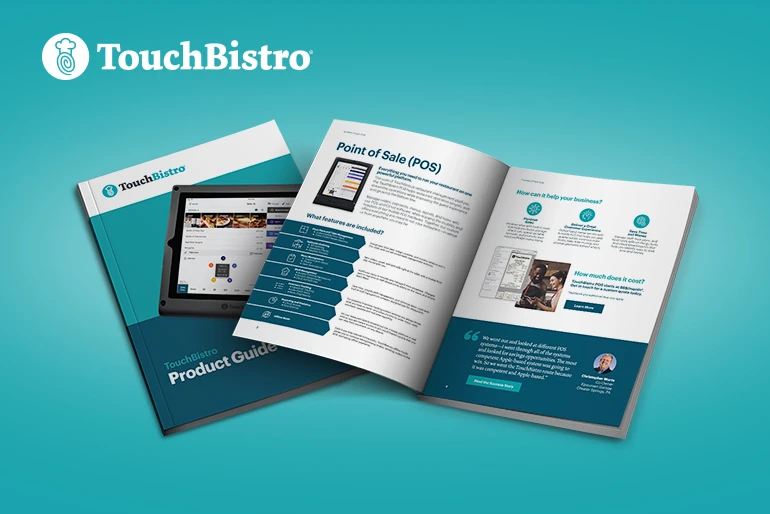Data is critical to your restaurant operations. It gives you insight into how your business is performing, and helps you optimize your sales, labor costs, inventory, and so much more. But this data is only valuable if you can easily access it, review it, and use the information to make necessary changes. That’s where cloud reporting comes in.
Cloud based reporting tools take the headache out of gathering and analyzing your restaurant’s data so you can make crucial business decisions. It may be a change from what you’re used to, but it’s actually simple and straightforward. And we’re about to break it all down.
In this guide to cloud reporting for restaurants, we’ll explore:
- What is the cloud?
- What is cloud reporting?
- Cloud vs legacy reporting
- 10 benefits of cloud reporting
Get ready to see your data in a whole new light.

Learn more about the different restaurant management solutions TouchBistro has to offer in this complete product guide.
What is the Cloud?
You’ve likely heard someone say the photos on their smartphone are “stored in the cloud.” But what exactly does that mean?
The cloud is a type of server. In the traditional sense, a server is “a computer that hosts a website on the internet,” explains Moz.
Here’s how the cloud is different: instead of using physical servers to host websites or store photos and other data, the cloud contains servers that people and businesses can access via the internet. Think of it like connecting to a central power grid that your entire state or country is using, as opposed to a generator on your property. This illustration shows how it works.

Cloud computing has been around since the early 2000s, but it’s becoming increasingly popular. According to G2, “by 2025, 85% of organizations will be ‘cloud first’, and four out of five enterprises plan to increase their cloud investment.”
The reason? The cloud offers numerous benefits for businesses (including restaurants), which we’ll dive into later.
What is Cloud Reporting?
Cloud reporting is a way of generating reports for your restaurant by accessing data stored in the cloud – for example, data from your restaurant POS system – instead of using an on-site server. These reports present your data in formats that are visually clear and understandable, such as charts, graphs, or searchable tables.
Here are a few examples of POS cloud reports you might want to run regularly:
- Sales by order type (dining room, takeout, etc.)
- Sales by menu item
- Payment details (date, time, value, etc.)
- Discounts and voids
- Labor cost analysis
To leverage cloud reporting, you’ll need software that connects to the cloud. Luckily, most modern restaurant POS software does. Since the cloud can securely hold massive amounts of data, you won’t need to be concerned about storage, either.
Cloud vs. Legacy Reporting
To fully understand the power of modern cloud reporting, let’s walk through how it compares to the alternative: legacy reporting via a physical server.
Say you need to grab a report from your restaurant POS. With cloud based reporting tools, you can access the data you need from your laptop, smartphone (or any other device), on the go, as long as you’re connected to the internet.
In contrast, with a legacy POS system, also known as “on-premise” or “traditional” POS,” you have to be physically inside your restaurant, in front of your POS system, to generate the report.
You also may not be able to access all of the data you truly need with a legacy system. “A legacy machine provides simple sales reports and customer data, which can help you understand trends and sales volume, but little more. Cloud-based machines give you access to a wide array of data,” explains Mews.
There are two major reasons for this improved access to data. First, as we noted, the cloud makes data immediately available to you instead of requiring you to sit down at your office computer to view it. Second, the ability to process and analyze data for business intelligence purposes is improved by using the cloud because it has a greater storage capacity than a legacy on-premise system.

The Benefits of Cloud Reporting for Restaurants
Now that we’ve covered the basics of cloud reporting, let’s explore the many advantages it offers you as a restaurateur.
1. Real-Time Insights
Restaurants are fast-paced environments with slim profit margins, and you need to be able to make decisions quickly to ensure your business stays profitable. The good news? Cloud reporting tools enable you to see most of your data in real-time so you can do exactly that.
For instance, running a restaurant performance report gives you a preview of how your business is operating at a given moment. It’s a live report that regularly refreshes, showing you the current cost of labor, current cost of sales, and current revenue.
This cloud report enables you to identify problems early and stop them in their tracks. For instance, if your labor costs for the day are creeping higher than your sales, you can cut a server instead of cutting into your daily profit.

Learn more about the different restaurant management solutions TouchBistro has to offer in this complete product guide.
2. Off-Premise Access
Leveraging cloud reporting means you don’t need to be in-venue to check on things and make changes. Take the example we just shared about the restaurant performance report. You can run that report and call your front-of-house manager to ask them to send a server home for the day, all from the comfort of your living room sofa.
The ability to access data anytime, anywhere ultimately means less time spent traveling to and from your restaurant, and fewer delays when important actions need to be taken.
3. Greater Transparency
To run a profitable restaurant, you need everyone on board helping to steer the ship. This can be challenging if you’re the only person on your team who can easily access data.
Cloud reporting tools enable you to share reports with whoever you choose at any time, so you can make data more accessible to your team. For instance, you may want to run weekly target reports to enable your shift managers to view server performance themselves in the cloud. This way, they’ll be better equipped to coach their team members on providing the best service possible, since they’ll have greater insight into what’s working well and what needs improvement.
4. Fewer Errors
Mistakes happen. It’s how you deal with them that matters. However, it’s difficult to address an issue when you can’t figure out exactly what went wrong. Cloud reporting allows you to see all relevant data in one central location, so you can verify information without having to look through numerous different systems or spreadsheets.
In addition, many cloud reports leverage automation, which removes the human element from data entry and record-keeping, minimizing human error altogether.
5. Easy Maintenance
When you have a legacy on-premise POS system, it often requires manual updates to keep it running smoothly. This means a software technician may need to come to your restaurant to update the system periodically for it to continue working properly, which can be inconvenient and costly.
With a cloud solution, most updates roll out automatically, removing the need for a technician to come in, and your software will always be performing at its peak level.
6. Affordable and Predictable Subscription Fees
Technology is a necessary investment for every restaurant, but that doesn’t mean it needs to break your budget.
Cloud reporting tools offered via a subscription model enable you to pay one affordable, predictable fee every month – instead of potentially paying huge amounts on random occasions for upgrades and maintenance you may not have been prepared for. In addition, cloud solutions typically come with a smaller upfront installation fee than on-site systems will cost you.
Wondering what cloud software will cost you? The investment will vary depending on the size of your business and the features you need. If you opt to include additional solutions, like digital ordering and loyalty programs, that will likely add to the total cost.
7. Improved Decision Making
The decisions you make today will ensure your restaurant’s future remains bright tomorrow – and for years to come. Unfortunately, poor decision-making when it comes to costs is one of the most common reasons restaurants fail.
This is why reporting is so important. Your restaurant reports aren’t just documents full of numbers – they’re critical insights that can make or break your business. Since cloud reports display more data than legacy reports and present that data in a more user-friendly way, they’re your secret weapon for making more informed business decisions, faster. These reports can save you thousands of dollars, prevent disasters, and let you know which issues need to be addressed ASAP.
For example, one restaurant decreased their cost of goods sold (COGS) rate by over 5%, while another reduced waste by over 10%, all thanks to issues spotted through their reports.
8. Simplified Multi-Location Management
Having the right technology is essential for any restaurant, but it becomes even more crucial when you’re operating a multi-unit restaurant business – that is, more than one location. If you need to visit each separate location you own just to access that venue’s data and generate reports, it can be a massive drain on your precious time.
Cloud reporting simplifies multi-location management. It allows you to see the performance of all of your locations at a glance and easily compare them. Once you see which location needs your attention most, you can deploy resources accordingly. For instance, if your reporting tells you that a certain seasonal dish is performing well at one of your locations, you could try launching the same dish at another one of your locations.

Learn more about the different restaurant management solutions TouchBistro has to offer in this complete product guide.
9. Increased Security
Cloud data is highly secure. It’s also safe from physical threats to your restaurant, such as a flood or fire. The data is regularly backed up, and backups occur on an automatic schedule.
Alternatively, while a legacy system using an on-premise server does provide you with complete control over your security, this isn’t necessarily a good thing.
“[You] are responsible for setting appropriate user access policies, installing firewalls and antivirus software, ensuring security patches are installed promptly, and guarding against cyberattacks,” explains Channel Futures. “If mismanaged, on-premise servers can leave an organization vulnerable to security threats.”
10. Better Guest Experience
At the end of the day, your restaurant’s reporting should help you improve your guests’ experience when they dine with you. For example, being able to access cloud reports on your most popular menu items can help ensure you’re ordering the correct amount of ingredients and that you always have enough inventory on hand for service.
Technology should help your restaurant run smoothly, not make your job more difficult. Cloud reporting tools do exactly that by providing you with real-time insights, anywhere you can access the internet. This is not only convenient – it’s also good for business. According to CloudZero, “a survey by Deloitte showed small and medium businesses that used cloud computing made 21% more profit and grew 26% faster.”
Cloud reports also give you the advantage of easily sharing data with the rest of your team to involve them in improving the guest experience and driving better performance overall. Thanks to easy maintenance and affordable, predictable fees, cloud solutions are an excellent option for any restaurateur, whether you own one location or 10.
Get the Complete Guide to Restaurant Reservations
Sign up for our free weekly TouchBistro Newsletter







